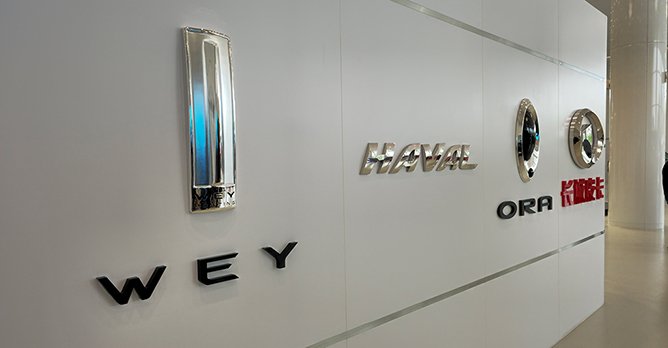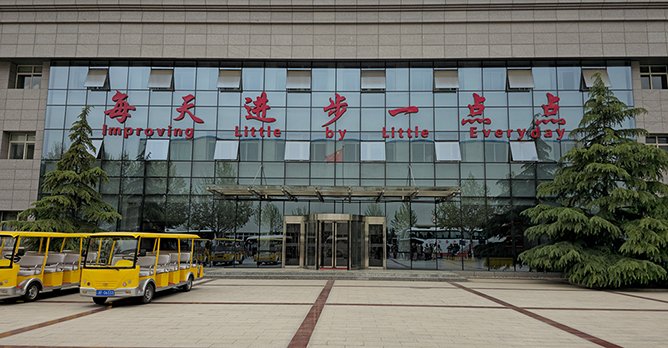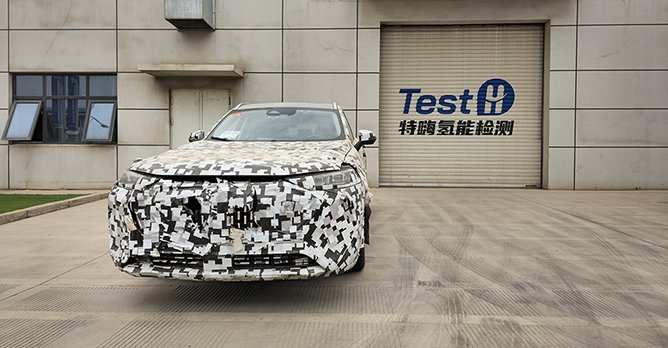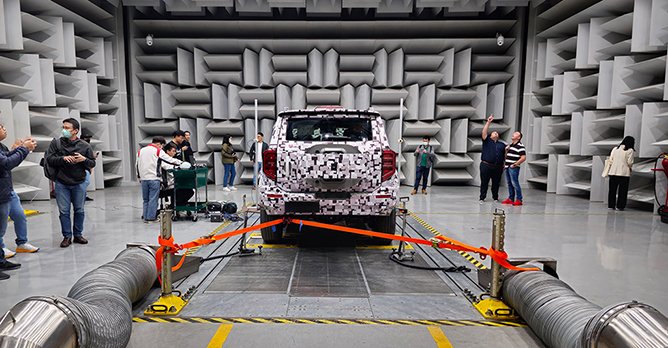Great Wall Motor leads the way in innovation and sustainability
25 Apr 2023|7,785 views
Great Wall Motor (GWM) is one of the fastest-growing automakers in the world, with its headquarters and a factory located in Baoding, China. Just last year, the carmaker sold over a million units, with smart cars accounting for over 85% of them. GWM owns several brands - Haval, Wey, ORA, Tank and Poer - with ORA being the most familiar brand to us since Cycle & Carriage announced its partnership with GWM to bring in the brand to Singapore in early March this year.
ORA, which stands for Open, Reliable and Alternative, is GWM's youthful and appealing electric vehicle (EV) brand, and the first model Singapore is expected to receive is the Good Cat. The Lightning Cat, a model that's a size bigger but no less attractive, may be coming to Singapore by the end of the year.
During my time at the headquarters and the factory site, it seems ORA isn't the only brand that's known for its innovative designs and high-quality vehicles. The rest of the models under the different brands seem to share the same sentiment. As for handling and comfort, I only had the chance to hitch a ride in the ORA Lightning Cat around a 7km-long high speed track located at the GWM Proving Ground.
I'm happy to say that the car is comfortable, premium and quick, even from the passenger's seat, which is the company's testament to growth and innovation. No surprises here, since 'improving little by little every day' is not just a slogan for GWM, but also believing in the daily advances in its systems for the betterment of customers' overall driving experience.
More than just high speed and brake testing, the factory is a marvel of modern engineering that clearly represents the country's capabilities of advanced technologies. For instance, while other carmakers are still perfecting their electric cars, the firm is already into hydrogen testing for its vehicles. At its Fuel Cell Laboratory, the largest in China at 20,000sqft, the equipment used can test for leakage, performance as well as low temperature.
There's also a proper NVH (Noise, Vibration, Harshness) semi-anechoic lab as well as a Vehicle BSR (Buzz, Squeak, Rattle) Lab to allow its vehicles to go through thorough testing to help verify and optimise every vehicle at the developmental phase.
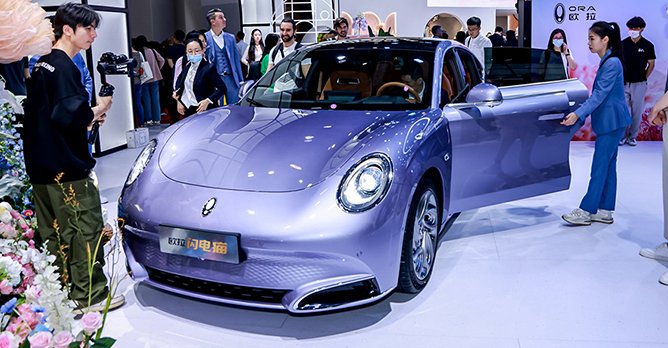
 One of the areas GWM has excelled in is producing electrified vehicles such as the Ora Lightning Cat (above) That said, perhaps one of the key factors that sets GWM apart from other automakers is its commitment to sustainability. The company has implemented a range of initiatives aimed at reducing its environmental impact, including the use of renewable energy sources in its factories and the development of more efficient and eco-friendly vehicles.
One of the areas GWM has excelled in is producing electrified vehicles such as the Ora Lightning Cat (above) That said, perhaps one of the key factors that sets GWM apart from other automakers is its commitment to sustainability. The company has implemented a range of initiatives aimed at reducing its environmental impact, including the use of renewable energy sources in its factories and the development of more efficient and eco-friendly vehicles.
That's certainly one of the areas in which GWM has excelled - electrified vehicles. As Singapore continues to push for more environmentally-friendly transportation options, such vehicles are becoming increasingly popular. GWM already offers a range of EVs in China, and the experience in producing these vehicles could make the company well-positioned to meet the growing demand in Singapore.
In addition, GWM has invested heavily in research and development (R&D), particularly in the areas of new energy vehicles to accelerate the pace from low carbon to zero carbon. In fact, a total of 100 billion Yuan has been pumped in by the company to ensure that it hits a global sales target of four million units by 2025. This commitment is likely to play a significant role in the future of the automotive industry, and GWM's expertise in these areas could give it an edge in Singapore.
Of course, there are also potential challenges that GWM will need to overcome in order to be successful in Singapore. One of the biggest obstacles is likely to be brand recognition, considering how it is still a relatively unknown brand in Singapore, which comes as a surprise since the firm has already established a global R&D system in China, Germany, Austria, South Korea, Japan and even the United States.
Another challenge is the highly competitive nature of the Singapore automotive landscape. With a number of well-established automakers already operating in Singapore, GWM will need to differentiate itself in order to stand out.
Still, with the carmaker's engineers and designers working tirelessly to create vehicles that are not only stylish and attractive but also highly functional and practical, GWM is expected to grow and expand its reach.
With its focus on innovation, quality, growth and sustainability, GWM is well on its way to becoming the next big thing in the automotive industry. Its success is a testament and a reminder that with hard work and dedication, anything is possible.
ORA, which stands for Open, Reliable and Alternative, is GWM's youthful and appealing electric vehicle (EV) brand, and the first model Singapore is expected to receive is the Good Cat. The Lightning Cat, a model that's a size bigger but no less attractive, may be coming to Singapore by the end of the year.
During my time at the headquarters and the factory site, it seems ORA isn't the only brand that's known for its innovative designs and high-quality vehicles. The rest of the models under the different brands seem to share the same sentiment. As for handling and comfort, I only had the chance to hitch a ride in the ORA Lightning Cat around a 7km-long high speed track located at the GWM Proving Ground.
I'm happy to say that the car is comfortable, premium and quick, even from the passenger's seat, which is the company's testament to growth and innovation. No surprises here, since 'improving little by little every day' is not just a slogan for GWM, but also believing in the daily advances in its systems for the betterment of customers' overall driving experience.
More than just high speed and brake testing, the factory is a marvel of modern engineering that clearly represents the country's capabilities of advanced technologies. For instance, while other carmakers are still perfecting their electric cars, the firm is already into hydrogen testing for its vehicles. At its Fuel Cell Laboratory, the largest in China at 20,000sqft, the equipment used can test for leakage, performance as well as low temperature.
There's also a proper NVH (Noise, Vibration, Harshness) semi-anechoic lab as well as a Vehicle BSR (Buzz, Squeak, Rattle) Lab to allow its vehicles to go through thorough testing to help verify and optimise every vehicle at the developmental phase.

That's certainly one of the areas in which GWM has excelled - electrified vehicles. As Singapore continues to push for more environmentally-friendly transportation options, such vehicles are becoming increasingly popular. GWM already offers a range of EVs in China, and the experience in producing these vehicles could make the company well-positioned to meet the growing demand in Singapore.
In addition, GWM has invested heavily in research and development (R&D), particularly in the areas of new energy vehicles to accelerate the pace from low carbon to zero carbon. In fact, a total of 100 billion Yuan has been pumped in by the company to ensure that it hits a global sales target of four million units by 2025. This commitment is likely to play a significant role in the future of the automotive industry, and GWM's expertise in these areas could give it an edge in Singapore.
Of course, there are also potential challenges that GWM will need to overcome in order to be successful in Singapore. One of the biggest obstacles is likely to be brand recognition, considering how it is still a relatively unknown brand in Singapore, which comes as a surprise since the firm has already established a global R&D system in China, Germany, Austria, South Korea, Japan and even the United States.
Another challenge is the highly competitive nature of the Singapore automotive landscape. With a number of well-established automakers already operating in Singapore, GWM will need to differentiate itself in order to stand out.
Still, with the carmaker's engineers and designers working tirelessly to create vehicles that are not only stylish and attractive but also highly functional and practical, GWM is expected to grow and expand its reach.
With its focus on innovation, quality, growth and sustainability, GWM is well on its way to becoming the next big thing in the automotive industry. Its success is a testament and a reminder that with hard work and dedication, anything is possible.
Great Wall Motor (GWM) is one of the fastest-growing automakers in the world, with its headquarters and a factory located in Baoding, China. Just last year, the carmaker sold over a million units, with smart cars accounting for over 85% of them. GWM owns several brands - Haval, Wey, ORA, Tank and Poer - with ORA being the most familiar brand to us since Cycle & Carriage announced its partnership with GWM to bring in the brand to Singapore in early March this year.
ORA, which stands for Open, Reliable and Alternative, is GWM's youthful and appealing electric vehicle (EV) brand, and the first model Singapore is expected to receive is the Good Cat. The Lightning Cat, a model that's a size bigger but no less attractive, may be coming to Singapore by the end of the year.
During my time at the headquarters and the factory site, it seems ORA isn't the only brand that's known for its innovative designs and high-quality vehicles. The rest of the models under the different brands seem to share the same sentiment. As for handling and comfort, I only had the chance to hitch a ride in the ORA Lightning Cat around a 7km-long high speed track located at the GWM Proving Ground.
I'm happy to say that the car is comfortable, premium and quick, even from the passenger's seat, which is the company's testament to growth and innovation. No surprises here, since 'improving little by little every day' is not just a slogan for GWM, but also believing in the daily advances in its systems for the betterment of customers' overall driving experience.
More than just high speed and brake testing, the factory is a marvel of modern engineering that clearly represents the country's capabilities of advanced technologies. For instance, while other carmakers are still perfecting their electric cars, the firm is already into hydrogen testing for its vehicles. At its Fuel Cell Laboratory, the largest in China at 20,000sqft, the equipment used can test for leakage, performance as well as low temperature.
There's also a proper NVH (Noise, Vibration, Harshness) semi-anechoic lab as well as a Vehicle BSR (Buzz, Squeak, Rattle) Lab to allow its vehicles to go through thorough testing to help verify and optimise every vehicle at the developmental phase.

 One of the areas GWM has excelled in is producing electrified vehicles such as the Ora Lightning Cat (above) That said, perhaps one of the key factors that sets GWM apart from other automakers is its commitment to sustainability. The company has implemented a range of initiatives aimed at reducing its environmental impact, including the use of renewable energy sources in its factories and the development of more efficient and eco-friendly vehicles.
One of the areas GWM has excelled in is producing electrified vehicles such as the Ora Lightning Cat (above) That said, perhaps one of the key factors that sets GWM apart from other automakers is its commitment to sustainability. The company has implemented a range of initiatives aimed at reducing its environmental impact, including the use of renewable energy sources in its factories and the development of more efficient and eco-friendly vehicles.
That's certainly one of the areas in which GWM has excelled - electrified vehicles. As Singapore continues to push for more environmentally-friendly transportation options, such vehicles are becoming increasingly popular. GWM already offers a range of EVs in China, and the experience in producing these vehicles could make the company well-positioned to meet the growing demand in Singapore.
In addition, GWM has invested heavily in research and development (R&D), particularly in the areas of new energy vehicles to accelerate the pace from low carbon to zero carbon. In fact, a total of 100 billion Yuan has been pumped in by the company to ensure that it hits a global sales target of four million units by 2025. This commitment is likely to play a significant role in the future of the automotive industry, and GWM's expertise in these areas could give it an edge in Singapore.
Of course, there are also potential challenges that GWM will need to overcome in order to be successful in Singapore. One of the biggest obstacles is likely to be brand recognition, considering how it is still a relatively unknown brand in Singapore, which comes as a surprise since the firm has already established a global R&D system in China, Germany, Austria, South Korea, Japan and even the United States.
Another challenge is the highly competitive nature of the Singapore automotive landscape. With a number of well-established automakers already operating in Singapore, GWM will need to differentiate itself in order to stand out.
Still, with the carmaker's engineers and designers working tirelessly to create vehicles that are not only stylish and attractive but also highly functional and practical, GWM is expected to grow and expand its reach.
With its focus on innovation, quality, growth and sustainability, GWM is well on its way to becoming the next big thing in the automotive industry. Its success is a testament and a reminder that with hard work and dedication, anything is possible.
ORA, which stands for Open, Reliable and Alternative, is GWM's youthful and appealing electric vehicle (EV) brand, and the first model Singapore is expected to receive is the Good Cat. The Lightning Cat, a model that's a size bigger but no less attractive, may be coming to Singapore by the end of the year.
During my time at the headquarters and the factory site, it seems ORA isn't the only brand that's known for its innovative designs and high-quality vehicles. The rest of the models under the different brands seem to share the same sentiment. As for handling and comfort, I only had the chance to hitch a ride in the ORA Lightning Cat around a 7km-long high speed track located at the GWM Proving Ground.
I'm happy to say that the car is comfortable, premium and quick, even from the passenger's seat, which is the company's testament to growth and innovation. No surprises here, since 'improving little by little every day' is not just a slogan for GWM, but also believing in the daily advances in its systems for the betterment of customers' overall driving experience.
More than just high speed and brake testing, the factory is a marvel of modern engineering that clearly represents the country's capabilities of advanced technologies. For instance, while other carmakers are still perfecting their electric cars, the firm is already into hydrogen testing for its vehicles. At its Fuel Cell Laboratory, the largest in China at 20,000sqft, the equipment used can test for leakage, performance as well as low temperature.
There's also a proper NVH (Noise, Vibration, Harshness) semi-anechoic lab as well as a Vehicle BSR (Buzz, Squeak, Rattle) Lab to allow its vehicles to go through thorough testing to help verify and optimise every vehicle at the developmental phase.

That's certainly one of the areas in which GWM has excelled - electrified vehicles. As Singapore continues to push for more environmentally-friendly transportation options, such vehicles are becoming increasingly popular. GWM already offers a range of EVs in China, and the experience in producing these vehicles could make the company well-positioned to meet the growing demand in Singapore.
In addition, GWM has invested heavily in research and development (R&D), particularly in the areas of new energy vehicles to accelerate the pace from low carbon to zero carbon. In fact, a total of 100 billion Yuan has been pumped in by the company to ensure that it hits a global sales target of four million units by 2025. This commitment is likely to play a significant role in the future of the automotive industry, and GWM's expertise in these areas could give it an edge in Singapore.
Of course, there are also potential challenges that GWM will need to overcome in order to be successful in Singapore. One of the biggest obstacles is likely to be brand recognition, considering how it is still a relatively unknown brand in Singapore, which comes as a surprise since the firm has already established a global R&D system in China, Germany, Austria, South Korea, Japan and even the United States.
Another challenge is the highly competitive nature of the Singapore automotive landscape. With a number of well-established automakers already operating in Singapore, GWM will need to differentiate itself in order to stand out.
Still, with the carmaker's engineers and designers working tirelessly to create vehicles that are not only stylish and attractive but also highly functional and practical, GWM is expected to grow and expand its reach.
With its focus on innovation, quality, growth and sustainability, GWM is well on its way to becoming the next big thing in the automotive industry. Its success is a testament and a reminder that with hard work and dedication, anything is possible.
Thank You For Your Subscription.



















